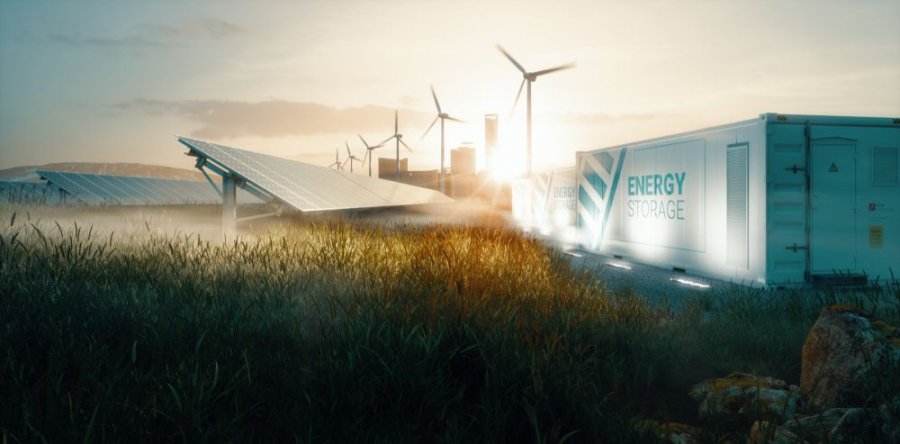By 2027, electricity consumption will grow by an average of 4% annually, but this increased demand will be met by renewable energy sources (RES) and nuclear power.
These data are provided by the International Energy Agency (IEA) in its report ‘Electricity 2025. Analysis and Forecast to 2027’.
Global electricity consumption is expected to grow at the fastest pace in recent years over the forecast period of 2025-2027. This is due to:
- growth in industrial production;
- increased use of air conditioning;
- accelerating electrification;
- expansion of data centres around the world.
In 2024, global electricity demand grew by 4.3% and is forecast to maintain this growth rate until 2027.
Key countries driving the increase in energy consumption
Most of the additional demand for electricity by 2027 will come from emerging and developing economies, led by China. They are expected to account for 85% of the growth.
In 2024, China accounted for more than half of the growth in global electricity demand. Domestically, it grew by 7%. According to analysts, the demand for electricity in this Asian country will grow by an average of 6% annually until 2027.
India, Southeast Asia and other emerging markets are also expected to see a significant increase in demand due to economic growth and an increase in the number of air conditioning owners.
India's electricity demand is expected to grow at an average annual rate of 6.3% over the next three years. This figure will exceed the average growth rate of 5% in 2015-2024.
Changes in electricity demand by region
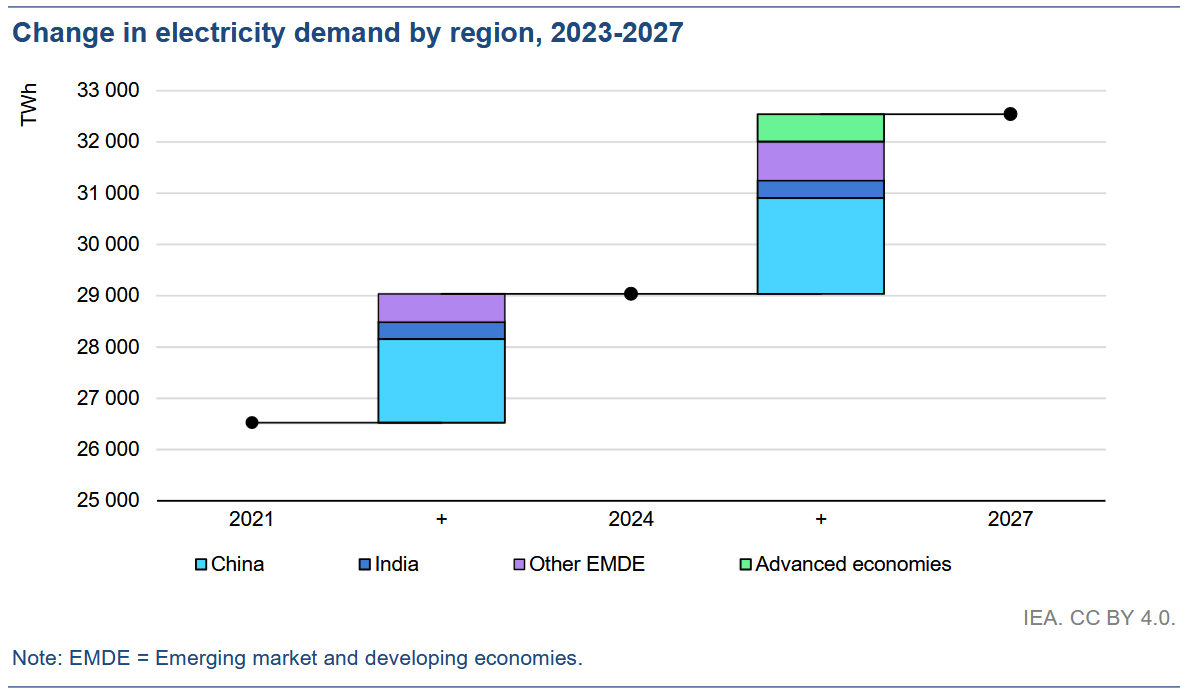
Source: iea.org.
The researchers noted that while many developing countries are experiencing steady growth in electricity demand, Africa is lagging behind.
‘Despite significant progress made in recent years, 600 million people in sub-Saharan Africa still lack access to reliable electricity,’ the report says.
Growth rates of electricity demand and GDP in selected regions, 2003-2027.
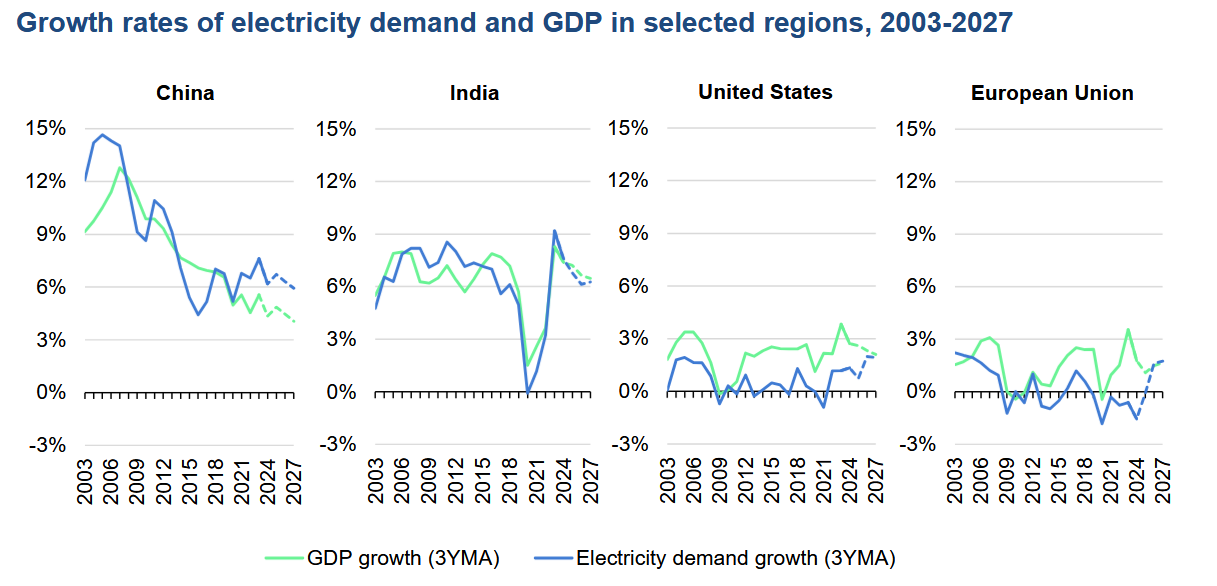
Source: iea.org.
Who is leading the way in electrification
Electrification is progressing the fastest in China. Here, the share of electricity in final energy consumption (28%) is much higher than in the United States (22%) or the European Union (21%).
Analysts note that China's industrial sector has become more energy-intensive, with solar photovoltaic modules, batteries and electric vehicles accounting for a third of the growth in demand.
Demand in advanced economies to start growing again
Demand in developed economies has remained relatively flat or even declined since 2009, even as the economy itself continued to grow. This trend has been driven by efficiency gains across all end-use sectors, particularly in lighting and household appliances, as well as the restructuring and relocation of heavy industry over the past few decades.
Experts now predict that developed countries will account for 15% of global demand growth in 2025-2027. The reasons include increased consumption due to the introduction of electric vehicles, air conditioners, data centres and heat pumps, as well as other end-use technologies.
In the United States, the world's second largest electricity consumer after China, demand recovered in 2024. It increased by 2% and reached a new high.
Demand for electricity in the European Union is recovering from the economic downturn that has affected the region in recent years, but is not expected to return to 2021 levels until 2027.
Low-emission sources will meet all demand growth
Analysts expect record high electricity production from renewables and nuclear power to cover all additional global demand over the next 3 years.
Solar, wind and hydropower will meet about 95% of the growth in electricity demand over this forecast period. In 2025, they are projected to account for more than a third of the world's total electricity generation, overtaking coal.
World electricity generation by source, 2014-2027
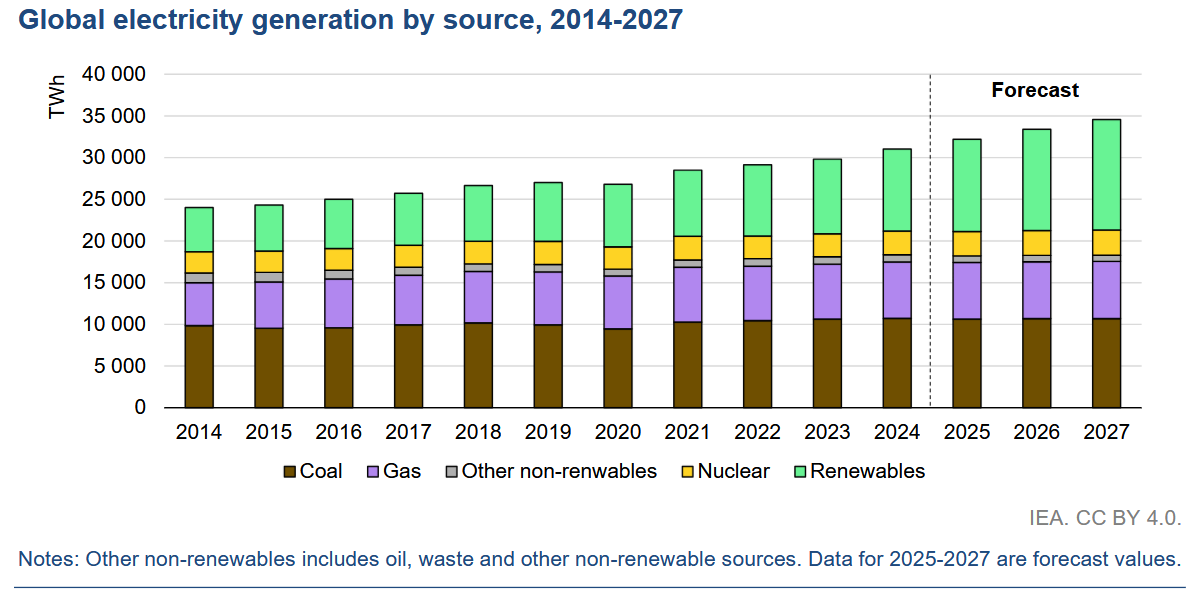
Source: iea.org.
According to researchers, renewables will more than meet the growth in demand in developed economies, thereby reducing electricity production from fossil fuels.
In China, the rapid expansion of renewable energy sources is expected to meet about 90% of new electricity demand, although weather events and unexpected changes in electricity consumption may affect this trend in some years.
Solar power
The report predicts that the rapid spread of lower-cost solar photovoltaic systems will account for about half of global electricity demand growth by 2027, up from 40% in 2024.
In 2024, solar photovoltaic generation worldwide will reach 2,000 TWh, accounting for 7% of global electricity production, up from 5% in 2023.
Analysts predict that over the next 3 years, solar energy will generate approximately 600 TWh of additional electricity annually.
‘Solar photovoltaics are booming around the world, setting records in both emerging and developed markets,’ the report says.
In 2024, electricity generation from solar power plants (SPPs) exceeded electricity generation from coal in the European Union, and their share in the generation structure exceeded 10%.
In China, the United States and India, the share of solar power will also reach 10% over the forecast period.
The steady growth trend of solar photovoltaic generation is accompanied by a further expansion of wind generation, which is projected to meet about a third of the additional global electricity demand in 2025-2027.
Nuclear power
In this sector, experts predict a new peak in 2025 and steady growth over the next 2 years with new records set. High growth rates will be ensured by the resumption of nuclear power production in France, the restart of nuclear power plants in Japan and the commissioning of new reactors in China, India, Korea and other countries.
Annual change in electricity generation by sources in selected regions, 2021-2027.
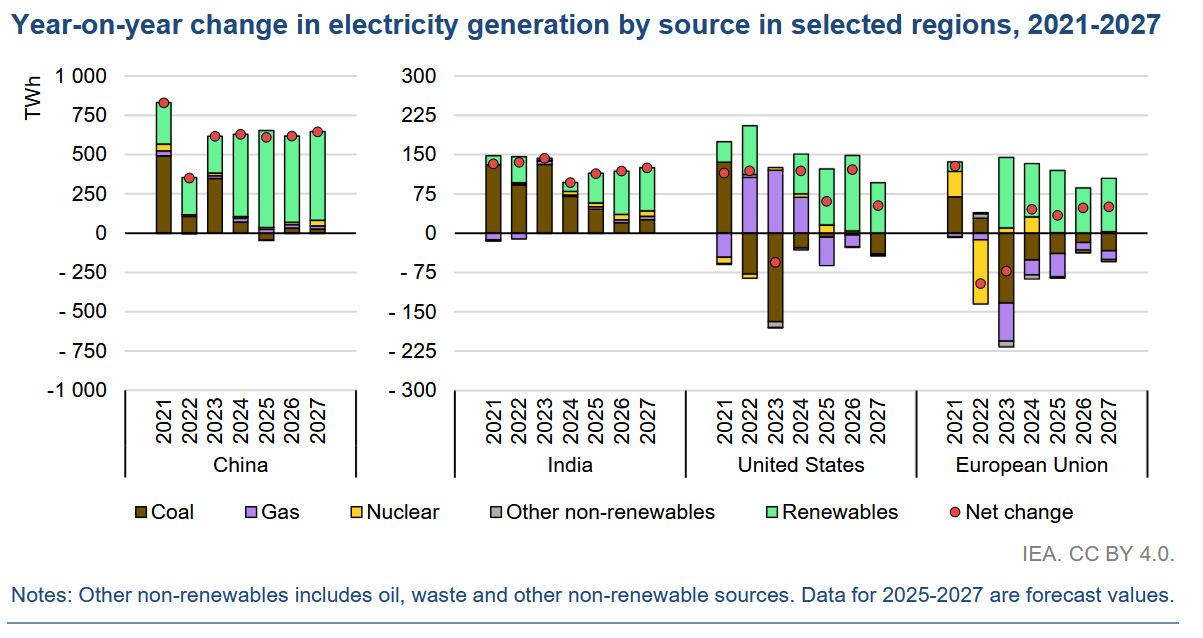
Source: iea.org.
Stabilisation of CO2 emissions from electricity generation
Global carbon dioxide (CO2) emissions from electricity generation are expected to stabilise over the 2025-2027 forecast period, after increasing by 1% in 2024. This will be due to renewable energy sources limiting the production of fossil fuels.
However, emissions from electricity generation remain the highest among all sectors. In 2024, they amounted to about 13,800 million tonnes of CO2. Global coal-fired generation is expected to stagnate over the forecast period after growing by 1% in 2024.
Recently, EcoPolitic wrote that China has become the undisputed leader among the world's countries in the construction of wind and solar power plants. At the same time, this country has started construction of 94.5 GW of coal-fired power plants in 2024, which is the largest volume of such new buildings since 2015.

